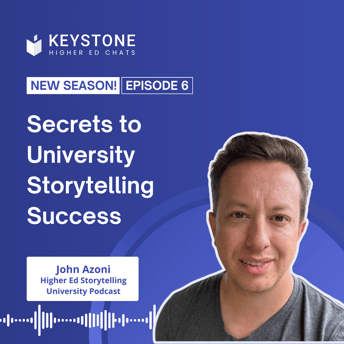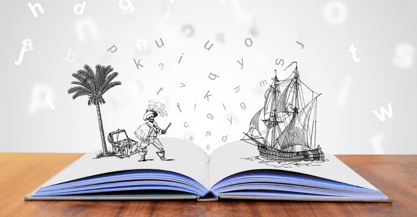- SERVICES
- HIGHER EDUCATION MARKETING
- ENGAGEMENT & ENROLLMENT MANAGEMENT
- STUDENT RECRUITMENT AGENCIES
- PROFESSIONAL EDUCATION & TRAINING
- WHO WE ARE
WHO WE ARE
Learn more about Keystone Education Group, including our leadership structure, why choose Keystone as your educational partner, and company press releases.
QUICK LINKS
- RESOURCES
RESOURCES
Find a range of helpful resources to help with your educational marketing. From on-demand webinars, reports & data, to customer testimonials and our downloadable media kit.
QUICK LINKS
- NEWS
- REQUEST A CALL

- Keystone Higher Education News
- Tips for Effective Storytelling in Higher Ed Marketing Strategy
“Storytelling” is a word that dominates higher ed marketing. Every school aspires to tell their institutional journey or highlight the stories of students and alumni as a means to attract new students... and many well-intentioned institutions think that they are.
But often, there is one major thing missing from all of these storytelling efforts.
An actual story.
What Storytelling Means Today
Imagine calling your friend and saying, 'I’ve got an amazing story to tell you… As a certified holistic nutrition counselor, I believe that nutritious food…blah blah.'
Your friend, however, would likely be confused, waiting for the actual story to unfold. Why?
Because, as humans, we are hard-wired to recognize when a story is being told. And the nutritional information you began with does not fit that mold.
What someone feels, believes, or is passionate about is not a story.
Why someone feels that way, holds that belief, or loves that thing, is also not a story. 
What is a Story?
A story is a series of connected events that share a cause-and-effect relationship, also known as a plot.
In other words, “This happened, then this happened, and because of that this happened.”
Now, consider these two examples:
There are boring stories, like: "I graduated high school and applied to a few different colleges. I got accepted to State University, which has the program I want to major in. I decided to enroll at State because it's close to home."
And then, there are compelling narratives, such as:: "Since I was young, I dreamed of being the first doctor in my family. I was a straight ‘A’ student through high school while working nights to help my family pay the bills, but as I neared graduation I accepted the fact that medical school was financially out of reach. One day the phone rang. It was the president of State University. He had heard my story and offered me a full-ride scholarship. Today as a board-certified doctor I run a clinic in my hometown that provides free medical care to impoverished families.”
Both are accounts of connected events that have a cause-and-effect relationship, fulfilling the technical definition of a story. However, the second one is undoubtedly more remarkable, demonstrating the power of a compelling and impactful narrative.
Narrative v. Declarative Storytelling... and When to Use Each
I like to frame the notion of storytelling into two distinct categories:
1. Narrative storytelling
2. Declarative storytelling
Narrative stories are actual stories.
Declarative stories are more anecdotal information, likely polished up to sound more artful and emotionally appealing, but information nonetheless.
One is not necessarily better than the other, but the psychological effects are very different between the two.
Use Narrative Storytelling to Hold Attention
fMRI scans show that a good story can synchronize our brains. As the protagonist succeeds, our dopamine spikes and our brains activate in a way where we share their triumph as if it’s happening to us.
When it comes to shaping beliefs and actions, studies have shown that the further transported or immersed someone is in a story, the more likely they are to align with the beliefs of the characters.
So if your college is telling the story of a student who, as an adult, went back to school against all odds but believed in herself enough to make it happen, chances are the person watching (or reading) will empathize, similarly believe in themselves and perhaps act on those beliefs.
Have you ever been listening to a speaker on stage and as soon as they start telling a story to illustrate their point, you’re zeroed in?
That’s because our brains are wired to favor narratives. They capture and hold our attention. And what good is our student marketing if we don’t have our audience’s attention in the first place?
When Declarative Storytelling is the Better Choice
Narrative stories aren’t necessarily the golden child of higher ed marketing. There’s a time and a place for everything.
If my plumbing springs a leak and water is pouring out through the walls, I don’t care to hear the story behind how your grandfather started the company. I want to know if I can trust you to fix my problem if you can get here fast, and if I can afford you.
I need direct information. Maybe through declarative storytelling, you develop extra trust with me by telling me that you value honesty and integrity, that you’re passionate about what you do, and that you believe in doing things right the first time and not taking shortcuts in your work.
When I’m trying to make a logical decision, I’m not in the headspace to be taken on a narrative journey.

Knowing When to Show and When to Tell
Ultimately, narrative and declarative storytelling both have immense value depending on the context and goals. Understanding when to employ a narrative vs. a declarative story is crucial for effective student marketing. Those institutions astute enough to adapt their strategies accordingly are poised to set themselves apart in a cacophony of competition.
👀Show:
Transportive stories that spark emotion and activate bonding chemicals in the brain stand apart for stirring hearts and minds. Narrative stories in the vein of student or alumni successes, or groundbreaking research projects sponsored by your institution that are solving real problems in the world are great tools for these purposes.
💬Tell:
On the other hand, straightforward, declarative, statements of beliefs and facts do a good job of providing logical reasons to trust.
For instance, when a prospective student seeks to understand what sets your program apart or when emphasizing a strong commitment to diversity and inclusion, straightforward declarations can instill confidence. This is particularly impactful for minority students, assuring them that they are likely to feel at home and find a welcoming environment.
There is a time to show and a time to tell. The institutions that know the difference will stand the best chance of attracting students to their institutions by standing out amidst all the noise.
Are you familiar with the keys to effectively telling university narratives?
Listen to John Azoni as he reveals the secrets on the Keystone Higher Ed Chats podcast. Click here to listen.
Effective storytelling is a cornerstone of successful higher education marketing strategies. Knowing when to employ narrative stories versus declarative ones is critical. Narrative stories captivate audiences by evoking emotions and fostering connections, making them ideal for showcasing student successes and impactful research initiatives.
Declarative stories, though, provide clear and concise information, making them valuable for presenting facts and instilling trust in prospective students.
By strategically incorporating both narrative and declarative elements, higher education institutions can create compelling marketing campaigns that resonate with their target audiences and drive enrollment.
Related Tags
Just For You
Top Picks
Higher Ed Chats Podcast
Listen to the latest episodes of our Higher Ed Chats Podcast - new format for 2024. Hear from Higher Ed thought-leaders from around the world!

Webinar: Dos & Don'ts of Higher Ed Social Media
.png?width=500&name=Social%20Media%20Webinar%20March%2024%20Banners%20(3).png)
Join our live webinar on 27th March to hear from a panel of Higher Ed Social Media experts.
Subscribe
to get the latest news and updates





